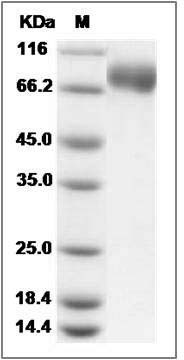-
Product Name
Mouse FLRT2 (His Tag) recombinant protein
- Documents
-
Description
Fibronectin Leucine-Rich Transmembrane (FLRT) proteins are glycosylated membrane proteins expressed at the cell surface which localise in a homophilic manner to cell-cell contacts expressing the focal adhesion marker vinculin. FLRT1, FLRT2, and FLRT3, the three genes encode putative type I transmembrane proteins, each containing 10 leucine-rich repeats (LRR), a type III fibronectin (FN) domain, followed by the transmembrane region, and a short cytoplasmic tail. FLRT family members may function in cell adhesion and/or receptor signalling. Each member of the FLRT family has a distinct, highly regulated expression pattern, as was seen for the NLRR family. FLRT2 is expressed in a subset of the sclerotome, adjacent to the region that forms the syndetome, suggesting that interaction with FGF signalling may be a general property of FLRT proteins. All FLRTs can interact with FGFR1 and FLRTs can be induced by the activation of FGF signalling by FGF-2. FLRT proteins have a dual role, promoting FGF signalling and modulating homotypic cell adhesion. FLRT2 played critical roles in craniofacial development, and it was also present in the vomero-nasal organ, mandibular primodia, and the posterior aspects of the unfused and fused secondary palatal shelves.
-
Protein name
Fibronectin leucine rich transmembrane protein 2
-
Protein short names
FLRT2; UNQ232/PRO265; KIAA0405
-
Uniprot ID
Q8BLU0
-
Gene Name
Flrt2; Map4k5; mCG_119917
-
Source/Expression Host
Human Cells
-
Expression Plasmid/cDNA
A DNA sequence encoding the mouse FLRT2 (Q8BLU0) (Met1-Ser539) was expressed with a C-terminal polyhistidine tag.
-
Protein Species
Mouse
-
Molecular weight
The recombinant mouse FLRT2 comprises 515 amino acids and has a predicted molecular mass of 57.6 kDa. The apparent molecular mass of the protein is approximately 68-78 kDa in SDS-PAGE under reducing conditions due to glycosylation.
-
Purity
> 95 % as determined by SDS-PAGE
-
Activity
Measured by the ability of the immobilized protein to support the adhesion of Neuro‑2A mouse neuroblastoma cells.
When cells are added to coated plates(5μg/mL,100μL/well), approximately 50%-70% will adhere for 1 hour incubation at 37℃. -
Validations

Mouse FLRT2 Protein (His Tag) SDS-PAGE
Related Products / Services
Please note: All products are "FOR RESEARCH USE ONLY AND ARE NOT INTENDED FOR DIAGNOSTIC OR THERAPEUTIC USE"
